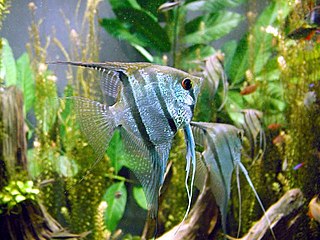
Pterophyllum is a small genus of freshwater fish from the family Cichlidae known to most aquarists as angelfish. All Pterophyllum species originate from the Amazon Basin, Orinoco Basin and various rivers in the Guiana Shield in tropical South America. The three species of Pterophyllum are unusually shaped for cichlids being greatly laterally compressed, with round bodies and elongated triangular dorsal and anal fins. This body shape allows them to hide among roots and plants, often on a vertical surface. Naturally occurring angelfish are frequently striped transversely, colouration which provides additional camouflage. Angelfish are ambush predators and prey on small fish and macroinvertebrates. All Pterophyllum species form monogamous pairs. Eggs are generally laid on a submerged log or a flattened leaf. As is the case for other cichlids, brood care is highly developed.

Hypostomus plecostomus, also known as the suckermouth catfish or the common pleco, is a tropical freshwater fish belonging to the armored catfish family (Loricariidae), named for the longitudinal rows of armor-like scutes that cover the upper parts of the head and body. Although the name Hypostomus plecostomus is often used to refer to common plecostomus sold in aquarium shops, most are actually members of other genera.

The walking catfish is a species of freshwater airbreathing catfish native to Southeast Asia. It is named for its ability to "walk" and wiggle across dry land, to find food or suitable environments. While it does not truly walk as most bipeds or quadrupeds do, it has the ability to use its pectoral fins to keep it upright as it makes a wiggling motion with snakelike movements to traverse land. This fish normally lives in slow-moving and often stagnant waters in ponds, swamps, streams, and rivers, as well as in flooded rice paddies, or temporary pools that may dry up. When this happens, its "walking" skill allows the fish to move to other aquatic environments. Considerable taxonomic confusion surrounds this species and it has frequently been confused with other close relatives. One main distinction between the walking catfish and the native North American ictalurid catfish with which it sometimes is confused, is that the walking catfish lacks an adipose fin.

Sterba's corydoras is a member of the South American Corydoras genus of freshwater aquarium catfish and one of the most popular species of Corydoras due to its attractive markings. The fish is native to the Guaporé River region between Bolivia and Brazil.
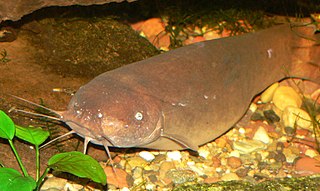
Malapterurus electricus is a thickset fish with six mouth barbels and a single fin on its back, just anterior to the rounded tail fin. It is brownish or grayish, irregularly spotted with black, and attains a length and weight of about 1.2 metres and 23 kilograms M. electricus is capable of generating and controlling the discharge of up to 450 volts of electricity. It uses its power to defend itself and to capture prey.

Pterygoplichthys or commonly known as janitor fish is a genus of South American armored catfishes. These fish are commonly known as sailfin armoured catfish or sailfin plecs.

Pterygoplichthys gibbiceps is a species of armored catfish native to Brazil, Ecuador, Peru and Venezuela where it is found in the Orinoco and Amazon basins.
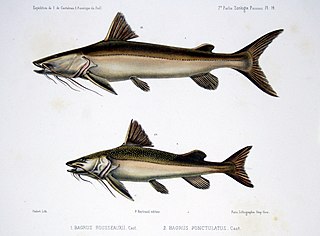
Brachyplatystoma is a genus of catfish from the family Pimelodidae. As the occasionally used common name goliath catfishes indicates, this genus includes some of the largest species of catfish, including the piraíba, B. filamentosum, which reaches up to the region of 3.6 metres (12 ft) in length. Brachyplatystoma are found in the Amazon and Orinoco basins, and other tropical freshwater and brackish habitats in South America. Some species are migratory. These fish are important as food fish and, to some extent, aquarium fish.

Batasio is a genus of catfish of the family Bagridae. These small fish are found in fast-flowing hillstreams throughout South and mainland Southeast Asia.
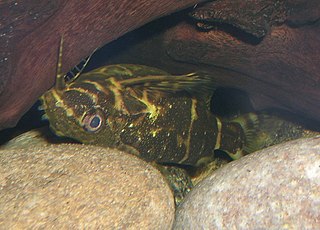
The name upside-down catfish is most commonly used by aquarists to refer to the mochokid catfish Synodontis nigriventris alternately known to ichthyologists as the blotched upside-down catfish or false upside-down catfish. However, a number of other fish may also be known by this name:

Mystus is a genus of fish in the family Bagridae native to Asia. Phylogenetic relationships within this genus are poorly understood, though it has been suggested that there are two major lineages.

Pseudacanthicus is a genus of medium to large-sized suckermouth armored catfishes native to South America, where found in the Amazon and Orinoco basins, as well as rivers of the Guianas. They are primarily found in fast-flowing waters, sometimes relatively deep. They are sometimes kept in aquariums.
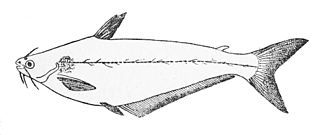
The African butter catfish is a species of fish in the family Schilbeidae. It is native to many major river systems in Africa. Other common names for the fish include butter fish, butter barbel, African glass catfish, lubangu, mystus catfish, silver barbel, and silver catfish. It was originally described as Silurus mystus by Carl Linnaeus in 1758.
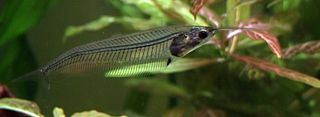
Kryptopterus vitreolus, known in the aquarium trade traditionally as the glass catfish and also as the ghost catfish or phantom catfish, is a small species of Asian glass catfish. It is commonly seen in the freshwater aquarium trade, but its taxonomy is confusing and was only fully resolved in 2013. It is endemic to Thailand, and found in rivers south of the Isthmus of Kra that drain into the Gulf of Thailand and river basins in the Cardamom Mountains. There are also unconfirmed reports from Penang in Malaysia.
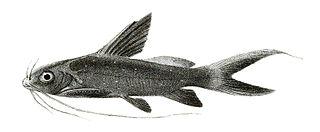
Mystus leucophasis is an Asian species of upside-down catfish belonging to the family Bagridae. It is known for its unusual behaviour, as it primarily swims in an inverted position and never upright.
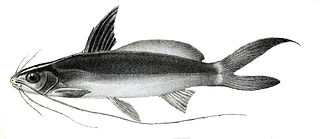
Mystus cavasius, the Gangetic mystus, is a species of catfish of the family Bagridae.

Mystus vittatus, the striped dwarf catfish, is a species of catfish of the family Bagridae. It is found in brackish water systems with marginal vegetation in lakes and swamps with a mud substrate of Asian countries Pakistan, India, Sri Lanka, Nepal, Bangladesh and probably Myanmar. Populations of Southeast Asian countries is in debate, due to close morphological similarities among Mystus species in that region.
Mystus ankutta, also known as the Sri Lanka dwarf catfish or yellow dwarf catfish, is a species of catfish of the family Bagridae that is endemic to Sri Lanka. In the wild it is found in freshwater bodies from Kelani river to Nilwala river in Sri Lanka.
Mystus albolineatus is a species of catfish endemic to Cambodia, Thailand and Vietnam, known from Chao Phraya River, Bang Pakong River, Mekong River and Tonlé Sap. It is found in flowing and standing waters especially near submerged woody vegetation; it feeds on zooplankton, fishes and insect larvae such as chironomidae. It spawns before or during the rainy season and the young were first caught in July and August. It occurs in both the market and aquarium trade and is fished with seines, gillnets and traps. It is not considered threatened thus listed Least Concern, however, further research about this fish is needed.
Mystus atrifasciatus is a species of catfish endemic to Cambodia, Laos, Thailand and Vietnam, known from Mekong River, Chao Phraya River and Mae Klong River and was described from Phitsanulok, Thailand. It inhabits rivers, streams and reservoirs and moves to floodplains when the water level increases and can also be found near submerged woody vegetation. It feeds on crustaceans and zooplankton along with some algae and fish scales. It is commonly fished and marketed and is also found in the aquarium trade. It may be threatened by pollution and overfishing and more research is needed about the species.

















